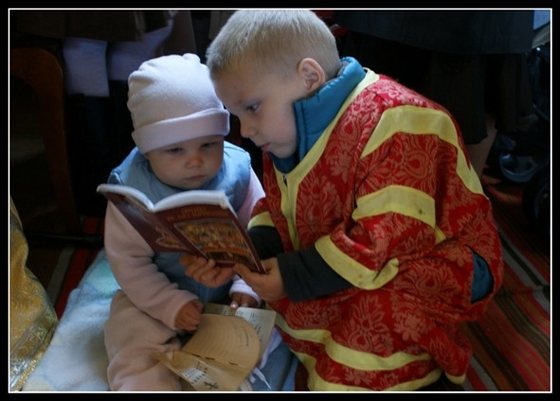In the past couple of weeks, I have shared some reflections on how we can offer our children a sound and living example of faith, one that they may readily choose to follow in their own adult lives. This week, I would like to conclude with a few suggestions on how to formally catechize your children at home.
Without belittling the dedicated and hardworking folks who weekly devote themselves to Christian education in their churches, I would suggest that effective catechism must primarily be rooted in a living relationship between parents and their children in the home. After all, if the primary witness to a child is his or her parents’ own lived example, shouldn’t the “talking” come from the same person who does the “walking”?
“Yes,” you might say, “but I am no expert the tenets of in my faith. I am not equipped to teach my kids doctrine!”
Let me share some of my experience as a professional teacher in this regard: kids can smell B.S. long before you hand it to them. What they really want to see is someone who is honest about what they know or don’t know. It’s quite okay for your kids to see that you too are a student. All that they really need to know is that finding the answers is important to you.
Whatever you do, therefore, don’t pretend you are more well-informed than you really are. I guarantee they will discover your lie and your claim to be representative of the truth will be seriously undermined.

So don’t worry about how expert you are. Simply embark on your own journey of learning, and having learned its lessons as thoroughly you can, pass them on as directly, honestly and as completely as possible to your children.
But what material do you choose and how do you actually teach it? With a bewildering variety of denominations, congregations and churches, not to mention claims to absolute truth throughout the Christian world, the task of finding a catechesis is overwhelming. However, it need not be so. Assuming a generally Christian context (the only one I am familiar with), I would suggest that the foundation for sound doctrine of any sort is a complete and deeply-rooted knowledge of the Old and New Testaments.
Don’t get me wrong here: I am not saying that Scripture should be sole source of a child’s doctrinal knowledge. As I have said before, Scripture is not self-interpreting and must be read and understood within a living framework of worship and spiritual practice—what Eastern Orthodox Christianity would call tradition.
Before a child can appropriate the proper interpretation of Scripture in tradition, however, he or she must first grasp what is being interpreted—the scriptural material from which tradition is wrought. To put it briefly, we can’t understand who Christ is “according to the Scriptures” unless we first know the Scriptures that ultimately point to Him!
In this view, I am not alone. The great 4th century preacher and teacher, John Chrysostom, offers similar advice in his homily, Address on Vainglory and the Right Way for Parents to Bring Up Their Children. Comparing the soul of a child to city and parents to lawmakers and rulers, Chrysostom emphasizes the importance of one of the city’s “gates”—the ears—by which “thoughts are corrupted or rightly guided.”
How to protect this particular gate in the soul of a child? Chrysostom’s prescription is twofold. Firstly, protect your child from stories that teach vices. He offers one example: “Such and such a girl kissed such and such a man, and had no luck and hanged herself.” In other words, Chrysostom urges us to prevent our children from hearing stories in which people are involved in the destruction of their souls.
For us, this means setting clear and firm boundaries about what books our children will read, what movies or TV shows they will see, what web sites they will visit, or what music they will listen to—itself a daunting challenge.
Secondly, Chrysostom urges that we offer our children stories from the Scripture. He tells us specifically how this should be done:
- Establish a context in which to establish a family storytelling tradition. Chrysostom advocates for an evening meal at which the whole family is gathered.
- Choose a story, such as that of Cain and Abel and having learned it thoroughly yourself, begin in the classic way: “Once upon a time.” At this stage, you need not insist on chapter and verse. The point is to teach the stories first, and only later to teach how they relate to one another in the wider scope of the Scriptures.
- Elaborate the story with relevant and appropriate details to engage the child’s mind. Include probable character motivations, as well as interpretations true to basic doctrinal teaching, e.g. Abel was received into heaven.
- Draw out simple, clear lessons from the story, e..g. the futility of Cain’s attempts to conceal his sins from God.
- Repeat the story for several nights and then ask the child to tell you the story in his or her own way.
- Provide the child with an opportunity to hear the story read and preached on in Church. In the Orthodox tradition, this would also involve them hearing hymnography that would interpret the story in the light of doctrine.
Whether we are able to follow Chrysostom’s prescriptions exactly is not of vital importance. The larger point is clear. If we make a start at living lives of faith for our own salvation and as an example to our children, if we establish with them a foundation by which they can understand that life of faith through the regular telling of stories from Scripture, then we will have already gone a long way to parenting children who will hold fast to Christ, not just until their dying breath, but beyond, into the age to come.
Fr. Richard is the Rector of St.Aidan Orthodox Church, Cranbrook, Canada. Please go to the parish’s website to read more articles by Fr.Richard.
















